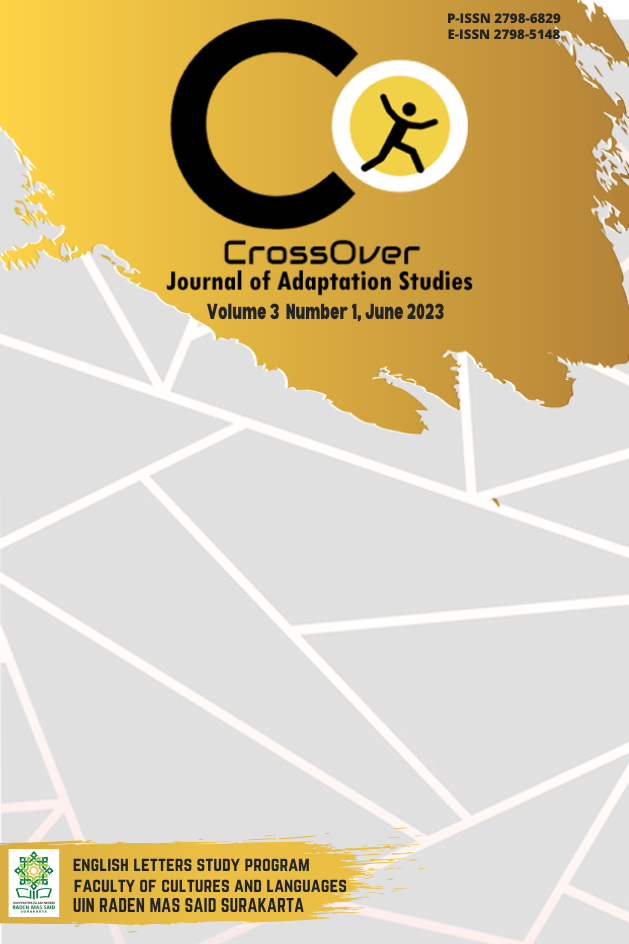THE NEED TO BLEED: NARRATIVE AMPLIFICATION OF KILLING SCENES IN “CASTLEVANIA” FROM VIDEO GAME TO TELEVISION SERIES ADAPTATION
DOI:
https://doi.org/10.22515/crossover.v3i1.6331Keywords:
killing scene, hyperviolent, amplification, adaptationAbstract
In this study, researchers discuss the adaptation from video games to animated films that focus on murder scenes, using Hutcheon's adaptation theory (2012) as a superordinate theory to analyze the adaptation that is present and being amplified from Castlevania video games to Castlevania animated films. Researchers aimed to reveal how Netflix adapted the video game Castlevania into the animated series with the same title through narrative amplification theory by Genette (1997) focused on murder scenes. The research data is in the form of textual-visual, visual-textual, and operative views from adaptation and object sources—data sourced from Castlevania Netflix adaptation and Castlevania gameplay footage. The selected game data source is the object that shows the adaptation and amplification in it. This study focused specifically on the hyper-violent killing scene that was significantly bloodier than the source material. The amplification of violent killing scenes in the adaptation are divided into three parts; Diegetic development, metadiegetic insertion, and extradiegetic intervention. Researchers found that the amplification process that focuses on the murder scenes from the game version is shown with less obvious effects, such as character flashing/blinking and then disappearing. In contrast, the animated version has gone through the amplification process. Blood and violence were shown, and the processes are shown in a more detailed and violent way.
Downloads
References
Akamatsu, H. (1989). Castlevania III: Dracula’s Curse [Game]. Konami.
Bell, A. (2010). The possible worlds of hypertext fiction. Springer.
Castlevania (TV Series). (2023, May 27). In Wikipedia. https://en.wikipedia.org/w/index.php?title=Castlevania_(TV_series)&oldid=1157227992
Das, P. (2021). “Die Monster! You Don’t Belong in this World”: The Spectre of Genocide in Japanese Digital Games. Acta Ludologica, 4(2), 130-131.
Ellis, W. (2017). Castlevania [Film]. Powerhouse Animation Studios.
Enășoiu, A. T. (2021). Transmedia Storytelling, Adaptation and the Cult Culture. Concept, 23(2), 102-115.
Genette, G. (1983). Narrative discourse: An essay in method (Vol. 3). Cornell University Press.
Genette, G. (1997). Palimpsests: Literature in the second degree (Vol. 8). U of Nebraska Press.
Hagihara, T. (1997). Castlevania: Symphony of the Night [Game]. Konami Computer Entertainment.
Hutcheon, L. (2012). A theory of adaptation. Routledge.
Kilbourn, R. J., & Faubert, P. (2014). Introduction: Film adaptation in the post-cinematic era. Journal of Adaptation in Film & Performance, 7(2), 155-158.
Krishnapatria, K. (2021). Penyajian Tema dalam Alih Wahana Game dan Serial Netflix Castlevania. Journal of Animation and Games Studies, 7(1), 25-42.
Kuhn, A., & Westwell, G. (2012). A dictionary of film studies. Oxford University Press.
Purnomo, S. L. A., Untari, L., Purnama, S. L. S., Asiyah, N., Muttaqien, M. Z., Umam, R. K., ... & Nurjanah, H. (2020). King size or all size: Proposing a typology of amplification translation technique for children picturebook translation. Studies in English Language and Education, 7(2), 558-575.
Santos, C. A. (2021). A multimodal analysis of representations of masculinity in Castlevania and Metal Gear Solid.
Stevens, E. C. (2021). Video Game to Streaming Series: The Case of Castlevania on Netflix.
Takeda, T. (2005). Castlevania: The Curse of Darkness [Game]. Konami Computer Entertainment.
Downloads
Published
How to Cite
Issue
Section
Citation Check
License
Copyright (c) 2023 Misbah Prayoga, Arista Putri Wulandari, Yuni Tri Fatonah, Dinda Kurnia Aldana, Ariefian Nugra Pradhana, Rofiah Tri Hastuti, Andika Prawijaya, Hakam Munaja

This work is licensed under a Creative Commons Attribution-ShareAlike 4.0 International License.
Authors retain copyright and grant the journal right of first publication with the work simultaneously licensed under a Creative Commons Attribution 4.0 International License that allows others to share the work with an acknowledgment of the work's authorship and initial publication in this journal.

















